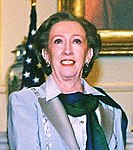European Parliament election, 1994 (United Kingdom)
|
|
|||||||||||||||||||||||||||||||||||||
|---|---|---|---|---|---|---|---|---|---|---|---|---|---|---|---|---|---|---|---|---|---|---|---|---|---|---|---|---|---|---|---|---|---|---|---|---|---|
|
|||||||||||||||||||||||||||||||||||||
|
87 seats to the European Parliament |
|||||||||||||||||||||||||||||||||||||
|
|||||||||||||||||||||||||||||||||||||
|
|||||||||||||||||||||||||||||||||||||
The European Parliament Election, 1994 was the fourth European election to be held in the United Kingdom. It was held on 9 June, though, as usual, the ballots were not counted until the evening of 12 June. The electoral system was, for the final European election, first past the post in England, Scotland and Wales and single transferable vote in Northern Ireland. This was the first election with 87 MEPs, the European Parliamentary Elections Act 1993 increased the number of seats for the UK from 81. For the first time, the UK did not have the lowest turnout in Europe. Turnout was lower in the Netherlands and Portugal.
This was the first European election contested by the recently formed UK Independence Party and the first European election in which the Liberal Democrats won seats. The Conservatives' performance in the election was very poor, losing a further 14 seats, taking their number of seats down to 18, which was 42 fewer seats than in the 1979 election, the year they defeated the Labour Party in the 1979 General Election. This reflected the general unpopularity of the Major government at the time.
...
Wikipedia


